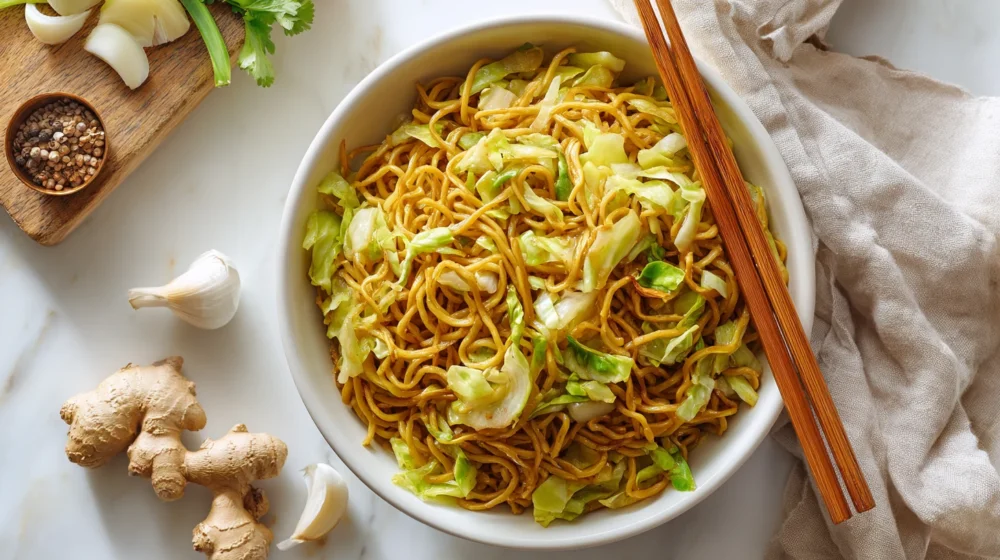
Ingredients
- 3 packages 5.6 oz each yakisoba noodles, seasoning packets discarded
- 1/4 cup soy sauce
- 1 tablespoon brown sugar
- 2 cloves garlic minced
- 1 teaspoon fresh ginger grated
- 1/4 teaspoon ground black pepper
- 2-3 tablespoons vegetable oil
- 2/3 cup celery chopped diagonally
- 1 medium onion thinly sliced
- 2 cups cabbage chopped
Instructions
- In a small bowl, whisk together soy sauce, brown sugar, minced garlic, grated ginger, and black pepper. Set aside.
- Remove yakisoba noodles from packages and discard the included seasoning packets. Rinse noodles thoroughly under cold water and drain well. Set aside.
- Heat vegetable oil in a large wok or skillet over medium heat. Add celery and onion, sautéing for 1-2 minutes until onions begin to soften and turn transparent. Add cabbage and cook for an additional minute, stirring constantly.
- Add the prepared noodles and sauce mixture to the vegetables in the wok. Stir-fry over medium-high heat for 2-3 minutes until noodles are heated through and evenly coated with sauce. Serve immediately.
There’s something absolutely satisfying about recreating your favorite restaurant dishes at home, and this Panda Express chow mein recipe has become one of my most requested meals. After countless experiments in my kitchen, I’ve finally cracked the code to making chow mein that tastes just like the mall food court version we all secretly love.
The first time I attempted this recipe was during a particularly busy week when I was craving that familiar combination of tender noodles and crisp vegetables but couldn’t justify the drive to the nearest Panda Express. What started as a quick weeknight dinner experiment turned into a family favorite that we now make at least twice a month.
What makes this recipe so appealing is its incredible simplicity. Unlike complicated stir-fry dishes that require exotic ingredients or special techniques, this chow mein relies on pantry staples and a straightforward cooking method. The magic happens in the balance of flavors – that perfect blend of salty soy sauce, subtle sweetness from brown sugar, and the aromatic punch of fresh garlic and ginger.
I’ve discovered that the secret to authentic-tasting Panda Express chow mein lies in using the right noodles. Yakisoba noodles, which you can find in the refrigerated produce section of most grocery stores, provide that exact texture and flavor profile. These pre-cooked noodles just need to be rinsed and heated, making them incredibly convenient for busy weeknights.
The vegetable combination is equally important. The holy trinity of onions, celery, and cabbage creates that distinctive crunch and flavor that defines Panda Express chow mein. I always slice my vegetables thinly and uniformly – this ensures they cook evenly and maintain their texture without becoming mushy.
One technique I’ve perfected over time is the cooking method. Using high heat and working quickly prevents the vegetables from releasing too much moisture, which can make the dish soggy. The key is to sauté the vegetables just until they start to soften while maintaining their crunch, then quickly toss everything together with the sauce.
The sauce itself is beautifully simple yet complex in flavor. The brown sugar adds that subtle sweetness that balances the saltiness of the soy sauce, while the fresh ginger and garlic provide depth and aromatic complexity. I always use fresh ginger rather than powder because it gives a much brighter, more authentic flavor.
This recipe has become a lifesaver for meal planning. It comes together in under twenty minutes, uses ingredients I typically have on hand, and feeds my family of four comfortably. Plus, it’s significantly healthier than the restaurant version since I can control the amount of oil and sodium used.
I love serving this chow mein as a side dish with homemade orange chicken or teriyaki salmon, but it’s equally satisfying as a main course. Sometimes I’ll add leftover rotisserie chicken or scrambled eggs to make it more substantial. The versatility of this dish means it works for quick lunches, family dinners, or even when entertaining guests who appreciate comfort food.
What surprises many people is how closely this homemade version matches the restaurant original. My teenagers, who are notoriously picky about my cooking attempts to recreate their fast-food favorites, actually prefer this version. They love that they can have it whenever they want without having to convince me to drive to the mall.
The texture is spot-on – those slightly chewy noodles with just the right amount of sauce coating each strand, punctuated by crisp-tender vegetables. The flavor profile hits all the right notes without being too salty or overpowering. It’s comfort food at its finest, familiar yet satisfying.
Storage and reheating are simple too. Leftovers keep well in the refrigerator for up to four days and reheat beautifully in the microwave or on the stovetop with just a splash of water to refresh the noodles. Sometimes I even prefer it as leftovers because the flavors have had time to meld together.
This recipe has taught me that the best copycat dishes aren’t about perfectly replicating every aspect of the original, but rather capturing the essence of what makes them appealing. In this case, it’s the combination of convenience, familiar flavors, and satisfying textures that makes Panda Express chow mein so popular.
Making this at home has become part of our family’s weekly routine, and I love knowing exactly what ingredients are going into our food. It’s a small way to maintain that connection to a favorite treat while having more control over nutrition and quality. Plus, there’s something deeply satisfying about mastering a recipe that brings such joy to the dinner table.




